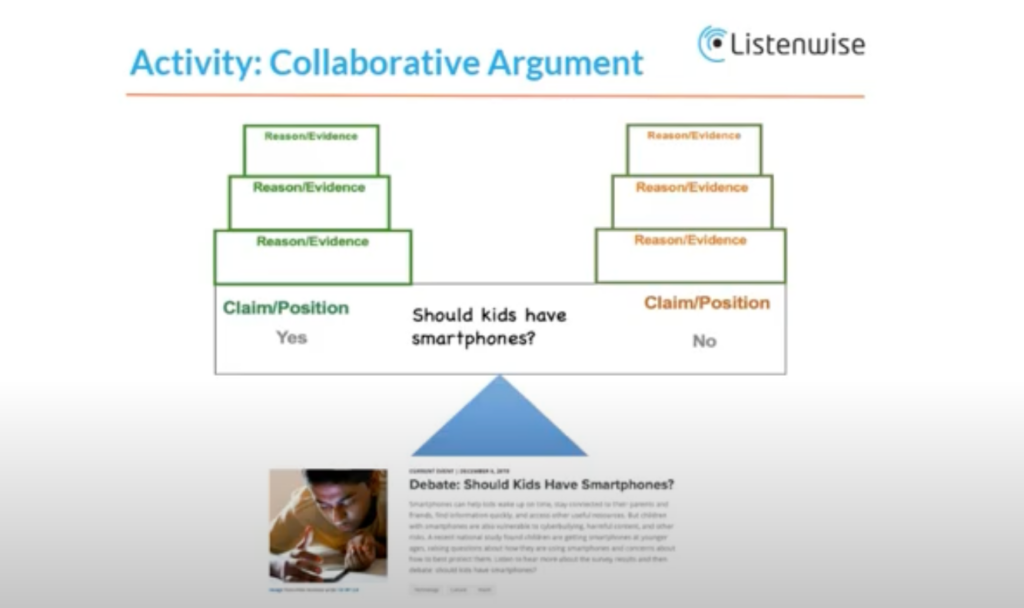
Elementary students often struggle to show that they are actively listening, an often-overlooked skill in the classroom. Taking time to teach listening skills for kids explicitly helps them understand the importance of that skill. Active listening is the act of intentionally listening to understand and respond. The listener is generally able to: Be engaged and […]
Elementary students often struggle to show that they are actively listening, an often-overlooked skill in the classroom. Taking time to teach listening skills for kids explicitly helps them understand the importance of that skill.
Active listening is the act of intentionally listening to understand and respond. The listener is generally able to:
- Be engaged and interested in the conversation and may ask questions
- Restate what the speaker has said
- Maintain consistent eye contact
- Use nonverbal communication, like nodding or facial expressions, that demonstrate that they are listening.
Active listening is a subset within the larger listening comprehension skill set. It can be broken down into discriminative listening, precise listening, strategic listening, and critical listening.
Active listening as a tool for student success
Students who can successfully use active listening skills can experience several benefits. Not only do students exhibit better comprehension, but they can become better problem-solvers and overall communicators. Other benefits may include:
- Increased ability to complete assignments
- Better understanding of curricular material
- Increased autonomy
- Better social relationships
- Increased resourcefulness
- Better collaborative skills
Creating space to teach listening skills for kids in the classroom explicitly encourages students to see the importance of listening – not only to their teachers but to their peers, as well.
Explore other teaching activities for teaching listening comprehension skills for middle and high schoolers. Also explore these listening comprehension test ideas for formative assessments. We also have strategies for how to teach listening skills to English learners.
How to teach a child active listening skills
One of the best ways to teach listening skills for kids is to model them. Students do learn many foundational skills by watching others. Teachers can model active listening skills with their students to show what it looks like to be an active listener by making eye contact, participating in meaningful conversations with students, and asking follow-up questions.
On the flip side, a fun classroom activity could be to model what active listening is not. Teachers could act like poor listeners by looking around the room, glancing at their phones, or simply walking out of the classroom. The key to this activity is to make everything dramatized so that it is evident that the teacher is using poor listening skills.
Once teachers have demonstrated what it looks like to be a lousy listener (and hopefully had some fun with it), students could have a classroom discussion about what the teacher did wrong and how it likely impacted the speaker.
Teachers should also utilize the power of positive reinforcement by recognizing when kids use active listening skills. If students see that others are being acknowledged for their stellar active listening skills, they will be more likely to use these skills themselves!
While teaching active listening skills may work in isolated instances, students will benefit more from lessons scattered throughout the curriculum. For the most success, teachers should implement active listening activities across different settings. That way, students can generalize this skill across multiple subjects.
Active Listening Exercises for Elementary Kids
Storytelling and Prediction
Read to students (or listen to a story) and ask them to write down or discuss predictions in small groups. By completing this activity, students will learn to listen to detail to make accurate predictions. For older students, teachers could take this activity further by asking them to write the ending to the story.
Write Down Questions or Use “Exit Tickets”
During a lesson, have students write down questions or comments that came up while listening to the teacher talk. Alternatively, a teacher could use an age- and level-appropriate news broadcast or a related podcast and have students ask questions or create study questions.
Students can either volunteer to share their questions with the group, drop their questions in a box at the end of class, or be asked to have a small-group discussion with other students.
This activity will likely vary depending on the age of the student. While the older elementary students might fill out questions on an exit ticket, younger students may do better by sharing out something they learned, a problem they had, or an interesting fact.
Sample lesson: Ask students to listen to the audio story “Woman Cooks 1,200 Lasagnas for Neighbors” and respond to the following question as an exit ticket:
- What are some other interesting ways to help our neighbors or people close to us when times are hard?
This can also be a good way to support empathy and other social and emotional learning (SEL) skills. Watch the video below for lesson ideas and teaching strategies shared by Dr. Scott Petri where he shares how he supports development of specific SEL competencies.
Simon Says
Many elementary school teachers use the Simon Says game in their classrooms, but fewer know the real benefit of this game. When playing Simon Says, students must listen carefully to follow the given directions, but they also have to listen for the name “Simon.”
To add some challenge to this game, try using other names that start with “s,” or make rules that students must follow, such as: “Simon says, everyone who is wearing red, jump three times.”
Memory circles
Having students repeat what was said before is a clever way to reinforce active listening.
Have students sit in a circle, either as a whole class or split into two circles, depending on the class size. The traditional way to play the game is something along the lines of “We’re going on a picnic, and so we brought….”
The first student would say a food that begins with the letter “A” (apple, for instance). The following student would repeat and add a food that starts with the letter “B” (e.g., bread), and so on.
The third child would say, “We’re going on a picnic, and we brought an apple, bread, and a car full of ants.”
The game can be modified to be items they saw in a picture book the class read, or the alphabet requirement could be removed to support fewer items or a more restricted topic.
Active Listening Exercises for Older Students

Collaborative Argument
(Zwiers, O’Hara, & Pritchard, 2014)
This listening comprehension tool asks teachers to use podcasts to provide content for students to develop a collaborative argument. Just as with “Stronger Clearer Each Time,” this activity serves to build academic vocabulary and listening skills.
First, provide students with a text to listen to and ask them to develop an opinion on the subject of the podcast. Instruct them that their opinion must be supported by reasons and evidence found in the text. Next, divide students into pairs and ask them to work together to complete a collaborative argument chart like the one seen below for “Debate: Should Kids Have Smartphones.”
To complete the chart, students should place the strongest/heaviest arguments in support on one side, and do the same for the “against” side.
T-Chart Pair Defend
(Perryman and Seidlitz, 2011)
This activity gives ELs an opportunity to practice building arguments through conversation. Not only does this require active engagement from students, but it also builds listening comprehension and critical listening skills.
Valentina Gonzalez recommends using “T-Chart, Pair, Defend” in combination with Listenwise’s weekly debate podcasts.
“The debate podcasts are fun for me because they’re really compelling to students,” explained Gonzalez, “They are about things that kids are going to be really interested in and want to hear.”
First, choose a debate podcast for students to listen to and take notes about on a t-chart that represents opposing positions. Next, brainstorm ideas on the t-chart as a class. Gonzalez recommends that teachers write out the t-chart by hand while students dictate their responses out loud.
Then, pair students and have them take turns role-playing each side of the t-chart. Ask one student to start off their mini-debate using their starter sentence from the t-chart. For example, Student A says: “Student B, I think that podcasts should be regulated because… some are spreading misinformation.” In response, Student B might say: “Student A, I see your point, however… podcasts should not be regulated because… the government should not regulate free speech.” In this example, students are reading directly from the content in the T-Chart, however some students may want to elaborate their answers.
Finally, partners switch sides and are asked to take the opposing point of view. If you have time, you may want to finish the lesson by having students complete a writing assignment where they get to choose a side and write out their personal opinion.

